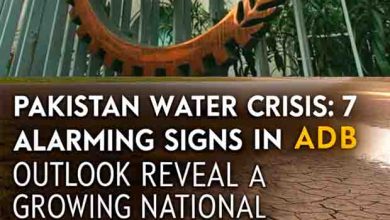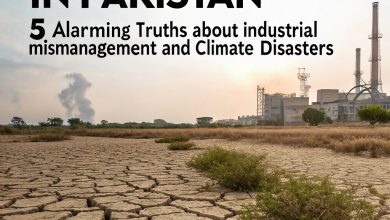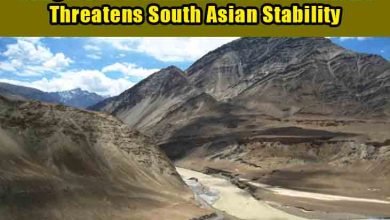Water Scarcity: A Growing Threat to Food Security in Pakistan
Water scarcity in Pakistan threatens national food security due to climate change, poor water management, and population growth. Learn how experts plan to fix it.
PESHAWAR, Apr 06 (APP) — Water scarcity in Pakistan is emerging as a critical national issue, jeopardizing food security and the livelihoods of millions. Experts warn that without immediate and coordinated action, the country’s agriculture-based economy could face devastating consequences.
The Water Crisis in Pakistan: A Brief Overview
Water scarcity in Pakistan, once a distant concern, has now become a direct threat to national food security. With per capita water availability dropping below 1,000 cubic meters, the country is officially in the water-stressed category, according to the Pakistan Council of Research in Water Resources (PCRWR).
This scarcity is not just a climate issue—it is a food crisis in the making. Agriculture, which consumes over 90% of available freshwater, is highly vulnerable to declining water levels.
Declining Water Availability and Agricultural Impacts
“Pakistan is home to one of the largest irrigation systems in the world, but water wastage and poor management have brought us to a critical point,” said economist Sumbal Riaz in an interview with APP.
The reduction in rainfall and snowfall, particularly in regions like Khyber Pakhtunkhwa (KP), has led to diminished reservoir levels, severely limiting water supply for irrigation.
Key agricultural concerns include:
-
Lower crop yields of water-intensive crops like wheat, rice, and sugarcane
-
Inefficient irrigation systems (flood irrigation wastes significant amounts of water)
-
Increased food prices due to decreased agricultural productivity
-
Threats to livestock and fisheries, key pillars of food diversity
Climate Change and Deforestation Intensify the Crisis
According to Gulzar Rehman, former Conservator of Forests, climate change is altering rainfall patterns and accelerating glacial melt, both of which disrupt the natural water cycle.
He added:
“Erratic weather events and deforestation have significantly lowered groundwater recharge rates and surface water availability.”
Pakistan’s forest cover is already below the global average. Combined with urbanization and industrial pollution, this has contributed to rapid ecosystem degradation.
Green Pakistan Initiative and Agricultural Innovation
Efforts like the Green Pakistan Initiative, launched in Cholistan by the Chief Minister of Punjab, aim to reverse the trend.
Highlights of the initiative:
-
Distribution of quality seeds, pesticides, and drones for precision agriculture
-
Establishment of a 5,000-acre model agricultural farm
-
Promotion of modern irrigation systems (drip and sprinkler)
-
Subsidized agricultural machinery for local farmers
Economist Sumbal Riaz noted,
“With adequate irrigation support, the southern districts of KP, Punjab, and Sindh can become food production hubs.”
The Role of Forestry in Water Resource Management
Ibrahim Khan, Deputy Project Director of the 10 Billion Trees Afforestation Project, shared that 26.7% of KP’s land is now forest-covered, surpassing international standards.
Impact of forestry initiatives:
-
Rs. 675 billion invested in green projects since 2014
-
Creation of over 175,000 green jobs
-
Rs. 100 billion annual potential in carbon credits
-
Improved land fertility and water retention through reforestation
“Forests play a pivotal role in stabilizing ecosystems and managing water cycles. Without them, the risk of floods and droughts increases manifold,” Khan emphasized.
Long-Term Solutions and Infrastructure Development
Experts argue that solving Pakistan’s water scarcity problem demands a multi-pronged strategy.
Key recommendations include:
-
Constructing new dams like Diamer-Bhasha, Mohmand, and Dasu
-
Rehabilitating existing canals and irrigation systems
-
Water conservation education among farmers
-
Wastewater recycling for industrial and agricultural use
-
Desalination plants in coastal regions
Current infrastructure projects such as the Chashma Right Bank Canal (CRBC) plantation and Mohmand Dam Canal Project are expected to irrigate over 500,000 acres, boosting both water availability and food production.
Conclusion and Way Forward
Water scarcity in Pakistan is no longer a looming threat—it is a present danger to national food security. The rapid decline in water resources, combined with climate change, outdated irrigation methods, and a growing population, is placing unprecedented pressure on the agricultural sector.
Urgent steps are needed to:
-
Build modern dams and water reservoirs
-
Promote water-saving agricultural practices
-
Invest in research and technology for sustainable farming
-
Encourage afforestation and wetland restoration
The future of Pakistan’s food security depends on how decisively the government, civil society, and private sector respond to this challenge.







